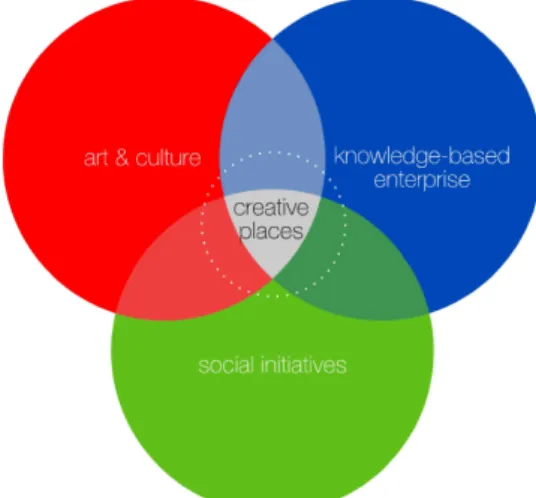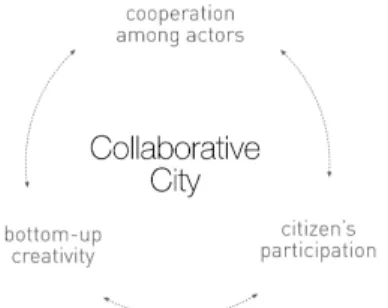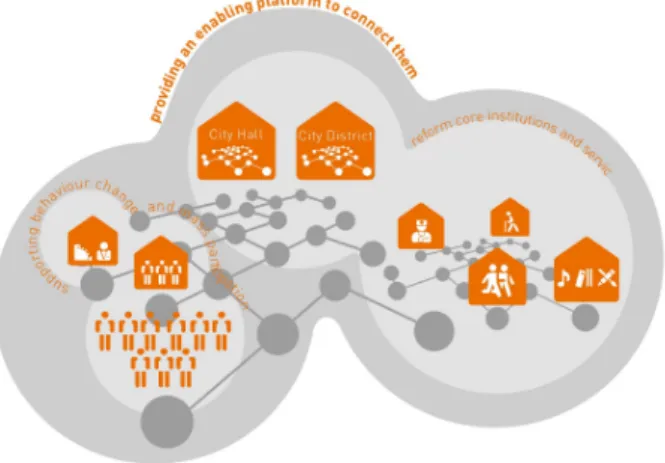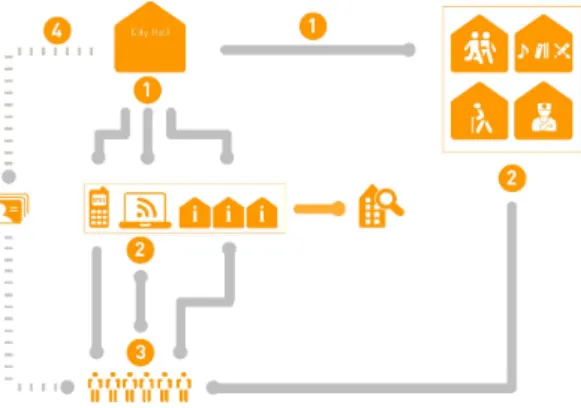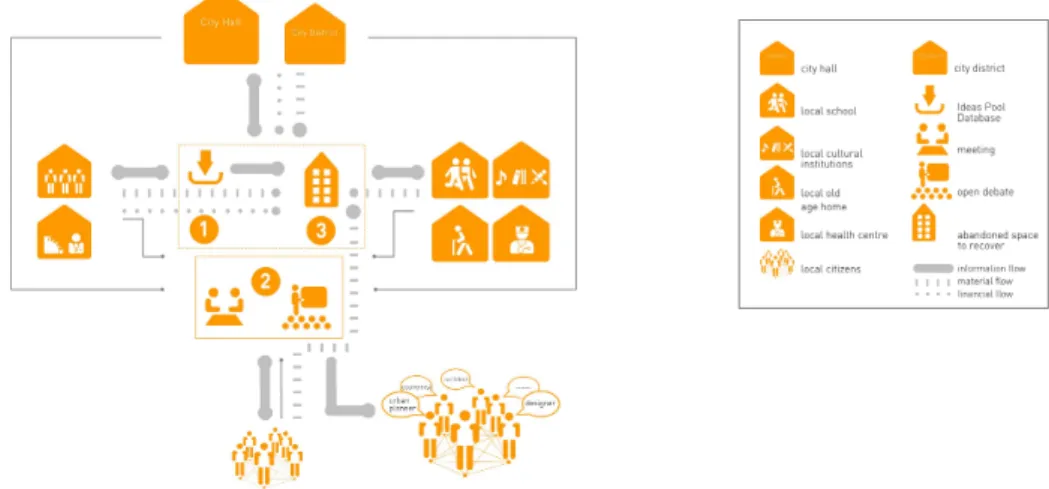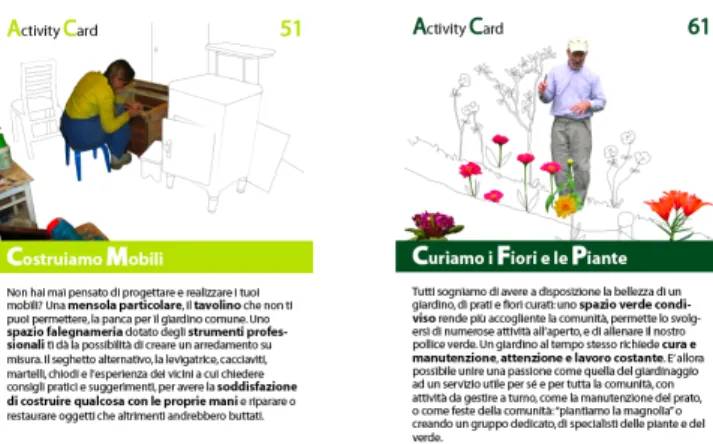Creative Places for Collaborative Cities
Teresa Franqueira*
* Univeridade de Aveiro / Politecnico di Milano Aveiro, Portugal / Milan, Italy, teresa.franqueira@ua.pt
Abstract: This paper will focus in the urban territory and its social, cultural and economic dynamics, and in particular in the different manifestations of creativity that can be found here, namely in spaces in which spontaneous and diffuse forms of social innovation and creativity are emerging: Creative Places.
It is in this urban context that Creative Places thrive, working as incubators of change, sustainable behaviours, bottom-up creativity and a subculture of collaboration. In this framework, Creative Places shape a Collaborative City, which in turn fosters the appearance of Creative Places.
The assumption of design as a strategic instrument to operate in complex systems involving complex networks of actors and able to decode, combine and make sense of multidisciplinary knowledge; and in so doing, able to decline it into a coherent projectual, flexible and open-ended language in order to promote the diffusion of sustainable social innovations and widen their reach and impact through designing for sustainability and for radical systemic innovation.
1. Introduction
The world is in a continuous and fastpaced change, whether we consider environmental, technological or economic transformations, or, even more significantly, whether we look at the social ones. The lack of policies adjusted to tackle those transformations and the need to adapt and develop systems able to structure the social, economic, and cultural fabric towards the transition to a more sustainable development model have given birth to a diffuse phenomenon of collaborative communities, in which individuals collaborate between them to produce the outcomes that the traditional welfare state does not seem able to deliver.
It is where we can observe the most unsustainable behaviours that, paradoxically, we can find the most promising solutions to the problems they produce: cities. As Landry argues, cities have in people their one crucial resource, and as they became large and complex enough to present problems of urban management, so they became laboratories that developed the solutions – technological, conceptual and social – to the problems of growth [11].
The idea that cities are the dynamos of national economies has contributed to a growing interest in the contribution that cities can make to the national welfare – and to economic competitiveness in particular. Cities matter to business in the knowledge economy because they are the places that offer organisations access to highly skilled workers and the opportunity to innovate and exchange ideas. Human cleverness, motivations, imagination and creativity are replacing location, natural resources and market access as urban resources [11]. In recent years creativity has been introduced in economic and urban policies as a key resource to compete in the global knowledge economy. Many creative city strategies have focused on providing the spaces - physical and social environments – to stimulate the production of creative contents and communities, the start up of value added economic activities and the regeneration of degraded urban areas [3]. On closer examination most of these city strategies have been actually concerned with strengthening the arts and cultural fabric and/or fostering the creative industries [10], which have the potential for wealth and job creation through the generation and exploitation of intellectual property.
Even though the emergent importance of creativity in and for this “new” world has generated a large literature in connection with cities, economy and culture, creativity as a social force has often been neglected. Creativity deriving from the urban context has many manifestations, whether it arises from professional activities, as a response to everyday-life problems, or as interventions from civic engaged groups interested in participating in the construction of their city.
2. Creative Places. An emerging phenomenon
There are a growing number of people, organizations and institutions behaving in a creative way in the contemporary knowledge society [6, 7; 19] and according to the Young Foundation Report [17] social innovations have been moving from the margins to the mainstream. From the EMUDE research [5], conducted at the Politecnico di Milano with the European Commission’s support, emerged that all across Europe ordinary people are making the extra-ordinary happen, expressing a diffused creativity put co- operatively into action by “non-specialised” people, embodying a significant expression of contemporary society [14].
From observation and desk research, it became apparent that those clusters of creativity, or Creative Places, are mostly found in cities, as the result of a special urban creativity deriving from the problems and potential of cities and the special response they require. Characterized by specialisms and niches as well as an innovative
mix of ideas, these places are the result of urban life itself in the sense that they result from a set of conditions only found in cities - optimal dimension or critical mass, cultural and ethnic diversity, universalism and large fluxes of exchange and interaction [11]. Also worth considering was that the shift from a period of industrial prosperity to a post-industrial one left behind abandoned industrial sites and unemployment, transforming booming neighbourhoods into rundown ones. This reality opened unforeseen perspectives, as some of those abandoned places were re-occupied and converted to new uses. The “available” architectures of those buildings, open-ended in their essence and with no predetermined role, welcomed new experiences and were open to various re-interpretations.
Those renewed and converted places upgraded the urban environment of entire neighbourhoods - they became spaces where groups of people could put in practice urban regeneration through, namely, a focus on culture and creativity as means of generating wealth, jobs, identity and active citizenship. They encourage people to get involved in civic initiatives and to get together to back common causes; they provide emotional and intellectual outlets in creation and in doing so they help people to form a better relationship with their environment and their lives; they promote social cohesion and inclusion and become active agents of a participatory democracy. They form the backbone of what we consider, for the purposes of this research, Creative Places.
Creative Places are a new type of urban spaces where groups of people collaboratively promote and manage a mix of creative initiatives in the fields of art and culture, economy and production, social services and urban regeneration.
They are very diverse but, at the same time, they have some strong common denominators, the most evident of which are that they are deeply rooted in their own city, but also open and cosmopolitan; and even though they are self-standing initiatives, the are also highly connected and depending on a complex interplay of top-down, bottom up and peer-to-peer interactions.
Creative Places gather 3 phenomena that are steadily gaining momentum: artistic and cultural production; knowledge-based enterprises; and social initiatives. But the existence of those 3 phenomena, does not, by itself, define a Creative Place. It is their simultaneous mix and confluence that is its defining characteristic. By amassing those 3 areas, Creative Places work as incubators of novel developments, as well as launchpads for what may be a more socially sustainable future.
In order to understand this phenomenon it was important to articulate an in-depth understanding of these places, how they work, the motivations and drivers behind their implementation, how they are organized, which kind of activities they develop and their impact in their surroundings, and crucially, how they can be replicated and diffused across the city. That was done through a Case studies methodology, carried out mainly through desk research. 13 cases were identified and between those, 4 were singled out to be analysed in-depth: UfaFabrik in Berlin (Germany) ; Grote Pyr in The Hague (The Netherlands); Republikken in Copenhagen (Denmark) and Fabbrica del Vapore in Milan (Italy). For this in-depth analysis, field research (through ethnographic methods) was applied.
Landry [11] refers that cities need “platforms for delivery”, as creative people and projects need to be based somewhere to develop entrepreneurial activity, to test ideas, pilot products and services. But they need them at an affordable price, reducing financial risk and therefore encouraging experiment and innovation. At the same time, the evolution of new governance dynamics, new planning and policy development paradigms and new organizational structures are also needed. Greater collaboration, cooperation and communication across and between governments, and public/private and non-profit jurisdictions are urgently required. In order to do this, it is necessary to develop innovative governance tools targeted at facilitating the very existence of innovative communities, a cultural and legal framework capable of dealing with the demands arising from new ventures [8], and a culture of collaboration.
Having said that, it is important to understand what collaboration is and its possible impacts in urban’s complex structure of governance and in the governance dynamics system in general.
Collaboration (or collaborative work) implies having a shared purpose, high-level of commitment, trust, flexibility, adaptation to change and clarity of objectives [18]. It is the capacity to solve problems or open new possibilities collaboratively among different actors.
Those are the characteristics of the individuals or groups of individuals who are behind Creative Places. If governments cannot manage more innovative and collaborative approaches to social problems, their citizens can. This perception is to become central in shifting governance paradigms in order to include those most affected by problems in their solution, since they are best positioned to understand the context within which their communities exist and the problems they face. In terms of the governance dynamics system in general, it means to change the extent of the principle of subsidiarity to include the citizens, meaning that decisions shouldn’t be taken as closely as possible to the citizen, but involving the citizen to ensure the decisions taken and solutions pursued are the best suited to address the problems.
For, as Landry [11] puts is, some of the most forward-looking creative work occurs at the grassroots level, where ideas can flourish, experiments can take place, and creative activity is less constrained by institutional bureaucracy and market imperatives. And local organizations not only respond more effectively to local needs than larger, top-down structures, but can also better focus and connect community resources to enable latent collaborative talent.
2. Collaborative City Concept
Cultural resources are the new raw materials of the city and creativity the method of exploiting these resources and helping them grow [11]. If to creativity we add collaboration, we can only imagine its potentiating effect to the exchanges taking place in the city.
A city with those two characteristics is a Collaborative City: a city with kernels of creativity and collaboration, which are constituted by social services, cultural and economic activities. This collaborative city is a place where people interact and enact creating a symbiosis of activities that promote sustainable lifestyles, active citizenship, social inclusion, cultural diversity, wealth and job creation, and alternative economic models. It is a city where hierarchies are transversal instead of vertical, i.e., where local authorities (urban leaders) create opportunities for mass participation, bottom-up creativity and collaborative services.
Figure 2. Collaboration Cycle for the “Collaborative City”
To be like this, a city should have a widespread leadership, being strategically principled and tactically flexible [11]. A collaborative city is open, as opposed to the structure of other urban government typologies, usually closed. For traditional institutions and organisations this means working differently, in collaboration with people who are not usual partners and within informal networks rather than formal frameworks [21]. To do this they need to develop an adaptive capacity that enables them to change the way they do things.
Collaboration allows the development of creativity hubs, social labs where new and alternative ways of doing and living more sustainably can be tried and essayed. In a nutshell, the collaborative city stimulates the participation of its citizens and the co-involvement of different actors, and in so doing fuels the emergence of Creative Places. But, how does a collaborative city work regarding its citizens, authorities, and formal institutions?
If we consider a system where collaboration is at the centre (figure 3), the traditional pyramidal structure disappears, and so does (ideally) its hierarchic rigidity.
Figure 4. Visual representation of systemic collaboration
2.1 Enabling System
Drawing from the cases’ observation, we can consider that communities and collaborative organisations are, to a large degree, bottom-up initiatives that give rise to promising cases of social innovations. But we have also seen that those initiatives are often supported and backed by information exchanges with other similar organisations and by different kinds of intervention by top-down institutions, and their implementation and subsistence depends very much on how successful is this set of interactions.
Hence, it is necessary to create the appropriate enabling platform for interaction. This platform is to be composed of enabling solutions to support a variety of collaborative services, that is, a system of products, services, communication, and whatever else necessary, to improve the accessibility, effectiveness, attractability and replicability of Creative Places - they are therefore activities and artefacts that support the service, both at its start up and in its day-to-day management, while raising the level of socialisation among participants making them co-producers of the value generated by the service [15].
And these enabling solutions and platforms should form the backbone of a wider enabling system, characterised by across-the-board tolerance and receptiveness towards spontaneous manifestations of creative collaboration. And materialised in socio-cultural, political-administrative and economic explicit and implicit support to emerging innovative communities and a set of instruments/tools that make that collaboration effectively possible.
As for the set of instruments necessary for it to work, it should allow people to participate in creating solutions that are tailored to their lives. This needs to account for the fact that, in some areas, the necessary elements already exist and must only be linked/enabled, whilst in other areas there may exist latent potential that needs to be unlocked (by means of designing its optimal fluxes and suggesting possible scenarios, for instances). What brings forward the need to design ways of interconnecting pockets of apparently unrelated social creative innovation in order to potentiate their synergies and most valuable aspects. All of the preceding should always be done resorting to organizations that are familiar with the specific needs of the neighbourhoods where the interventions happen.
3. Implications for design
Creative Places have the potential to be strong enablers of new and socio-culturally sustainable ways of being and doing, and the Collaborative City has the potential to foster the emergence and diffusion of Creative Places;
i.e., Creative Places shape a Collaborative City, which in turn fosters the appearance of Creative Places. Having realised this, the designer should step in and contribute to make this cycle a virtuous one.
Cities are very complex systems; a Collaborative City, with open and non-hierarchical structures, where everybody can participate and collaborate, can become even more complex. To intervene in this complex fluidity demands a holistic approach, a level of systems thinking and the orchestration of a range of different design inputs.
3.1 Strategic design for sustainability and radical systemic innovation
The research undertook highlighted how social innovations can change behaviours and shift attitudes in the transition towards sustainability; we have also seen that it is possible to promote the diffusion of sustainable social innovations and widen their reach and impact through the design of enabling solutions and enabling platforms. This means that designing for sustainability also implies designing for radical systemic innovation. The tools to develop this design activity are, usually, the tools used in strategic design, in which the project’s object is a broad system composed by products, services and communication defined as system-product, and the outcome is an integrated approach to the problem at hand. Talking about Design for Sustainability implies talking about designers who operate in complex systems involving complex networks of actors, and in a setting where there is no-obvious client (it can be an institution, an organization, a group of citizens). Operating in such complexity, to facilitate and support the ongoing diffuse design activity that happen in such systems, the designer has to make use of the strategic design instruments available to him: generating ideas of possible solutions from the dialogue with different interlocutors, representing them visually, inscribing them in wide and articulated scenarios represented in visible, synthetic and participatory forms. So, we can talk about strategic design for sustainability [16]. And, as mentioned above, strategically designing for sustainability implies strategically designing for radical systemic innovation, what should entail to promote and facilitate the integration in the systemic process of change, fostering desirable discontinuities in the existing status quo, coherent with the fundamental sustainability criteria.
4. Strategic design guidelines for Creative Places and the Collaborative City
If the contexts where innovative communities exist cannot be designed, some of their characterising elements can be conceived and realised. It is possible to identify and develop material and immaterial elements that work together in a given context to enhance its chances of becoming a fertile ground for creative, bottom-up initiatives. That is to say, it is possible to improve a context’s capacity to support innovative communities, and to enable a large number of potentially innovative citizens to move in the same direction [11, 9; 12, 13]. In order to do so it is necessary to actively promote a dialogue that will enable the convergence of groups of people and organizations, optimising and potentiating their resources, skills and ideas. Namely by suggesting the tools that will facilitate/support stakeholders in the process of promoting radical innovation and providing a platform for collaboration, co-creation, and participation.
According to Tapscott [20], open platforms are mass collaboration in action. In a world of co-creation and combinatorial innovation, an open platform allows for the building of a base of innovators that can make the system stronger, more dynamic and more expedient, facilitating the interaction between citizens and their governments. Government agencies are one of the largest sources of public data which, most of it, goes
completely unutilized when it could provide a platform for countless new public services [20], as neighbourhood renewal initiatives, abandoned spaces’ reuse, community development, and so on. Given the possibilities for collaboration between multiple actors, as presented in figure 4, and assuming the premise that the optimal conditions for a Collaborative City to work are in place, design may have a role to play in the enhancement of the efficacy and efficiency of the system.
A draft of a possible system to assist in the convergence and sharing of ideas between citizens and urban authorities was designed (figure 5), followed by a possible set of strategic design guidelines with practical examples of the tools and skills needed to orchestrate the challenge of creating an enabling system that stimulates the appearance, preserves and replicates Creative Places. If the pre-required conditions for the system to work are available, then it becomes possible to promote a fruitful dialogue between different actors and deliver the outcomes envisaged by them. Always keeping in mind that helping to design a Collaborative City that fosters the appearance of Creative Places involves proactive, participatory, collaborative, flexible and open-ended outlooks on the part of the designer.
Figure 5. Actors and Interfaces’ System Map
The system map presented above shows a possible configuration for a platform that enables communication between diverse actors interested in finding/reusing abandoned spaces. It is a scenario that assumes that the strategic designer’s proactiveness and sensitiveness enabled him, through a design approach, to observe and read the signals emerging in the urban context, to see beyond their short-term strengths and weakness and foresee their opportunities and threats, and thus propose possible scenarios for their development – by proposing to institutions mechanisms to foster emerging creative initiatives, like how to allocate/find spaces for those initiatives to take place, how to get people with common goals together and how to make them collaborate and communicate through diverse levels - in collaboration with experts in other fields. Employing a design approach brings multiple benefits, such as mechanisms for placing the user at the heart of a solution and for experts to collaborate equally on complex issues; a rapid, iterative process that can adapt to
changing circumstances; and a highly creative approach to problem-solving that leads to practical, everyday solutions. As such, this is a highly transferable process.
Phase 1.
Considering that a multidisciplinary group of experts, in which the designer is integrated: observed the urban territory and the emergence of social innovations and creativity in diffuse and unconnected pockets; acknowledged its potential for strengthening the socio-cultural and economic fabric of the city; identified as essential the existence of places where spontaneous and “de-localised” creative initiatives (existing and future) can find space to develop innovative socio-technical experimentations; recognised that the benefits of social innovations, which can be cascaded to the wider community given the right amount of support, can be potentiated if the Creative Places where they are developed and the social entrepreneurs behind them are backed by the right enabling system; proposes to the relevant local authorities: the survey of all abandoned / available spaces which can be reused by groups of citizens to develop creative activities; to develop an effective communications channel to disseminate that information between the citizens and that welcomes and fosters their contributions and participation, i.e., to create opportunities for mass participation; to engage in discussions with groups of citizens interested in promoting creative activities and regenerating specific spaces, neighbourhoods or areas, i.e., to foster bottom-up creativity and collaborative services; the study (for future adoption) of policy measures to enable the appearance and diffusion of Creative Places and for their connection into a citywide connected network, i.e., to promote the emergence of connected kernels of creativity and collaboration constituted by a mix of social services, cultural and economic activities, which constitute a Collaborative City. Here the designer should help to design the interface of and for the interactions to take place and to propose policy-orienting scenarios targeted at facilitating political decisions. Besides endowing it with a holistic strategic vision, he could also design tools such as: concept sketches, representational diagrams, scenarios, storyboards, plans, visual frameworks and models, in order to promote meaningful dialogue between all stakeholders.
Phase 2.
In a second moment, through the use of communication skills that are in the field of his expertise, the designer should help to communicate the project to citizens, as well as to the administrative structure that will support its success. The key aim is to mobilise citizens and raise their awareness to the active role they can play in the construction of a more liveable, sustainable city, and at the same time foster the emergence of a socio-cultural, political-administrative ground favourable to creative initiatives. In this phase it is important that information is widely accessible, and this should be made possible through the active involvement of local institutions/places citizens have more direct contact with (schools, healthcare centres, public libraries, local theatres, local businesses, etc). It is also important that the designer can highlight and communicate best practices and successful cases and their positive outcomes, so that they can act as attractors and thus stimulate interest in their reproduction and adaptation, always focusing on the importance of place and local impact. Furthermore, and as in these cases creativity and technology play a crucial role and Web 2.0 technologies have made possible the convergence of communication, grassroots creativity and active citizenship, the designer should help with specific advice when new procedures and/or new technologies have to be integrated, involving
the relevant experts whenever required. The efforts to foster active citizenship and cities regeneration through innovative technological systems and to integrate e-participation into everyday political and civic life are not novel [1]. However, there is plenty of room for the exploration on how citizens can actively and locally exploit their roles as ‘produsers’ - producers and users of technologies, but also of content and services collectively generated [2]. New media can foster the ‘ephemeral’ practices of cultural citizenship to enhance social networking, community building and emplaced definitions of new sustainable solutions for everyday urban living.
Designers’ inputs at this stage can be made tangible through the creation of various instruments (like the ones presented in the figures) such as: a Web platform; telecommunications; communication elements as flyers, posters, outdoors, advertisements; a citizen’s scorecard, etc.
Figure 6. Actors and Interfaces’ System Map for decision-making
Phase 3.
In this phase, the convergence between citizens with related interests has been achieved and the space in which they have shown interest in regenerating and dynamising identified. To foster participation and collaboration and to discuss the ideas uploaded onto the ideas pool database (that functions much like a crowdsourcing process) so as to reach a common ground, an open debate should be organised between all stakeholders: citizens involved in the starting-up of the Creative Place, representatives of local authorities and organisations (such as schools, libraries, health centres, local businesses, relevant public offices, etc.) and a multidisciplinary team of experts to help them in the strategic design of the process (designers, urban planners, architects, sociologists, economists, etc). Here, designer should act as an interface between these different actors, acting as a facilitator of others’ ideas and of interrelations, capable to bridge diverse points of view and facilitate collaboration through his specific set of design skills and instruments - to help clarify and visualise different and comparable visions, propose possible alternatives or scenarios and illustrate potential results arising from best known practices.
Figure 7. Scenario Building for strategic discussion
Figure 8. Storyboard. (Source: www.sustainable-everyday.net)
His role is not to act as a conflicts mediator or negotiator (these roles should be played by experts in those fields), but to deliver tactical outcomes – communications, tools, products, environments - through design orienting scenarios, conceived as tools to be used in the process of designing the creative place. This scenario building has to convey visions based on considerations that the scenario builder (designer) may share with, and ideally build with, the potential scenario users, proposing them as an integral part of the scenario itself (a collectively imagined scenario).
Another design tool that should be used at this stage are the activity cards for user participation, as they display a variety of powerful tools and techniques for successful user involvement, facilitating the choice of possible future activities; they are easy-to-use-tools to help in the discussion and brainstorming of ideas, orienting it with practical considerations and concerns.
Figure 9. Activity Cards. (Design by Roberta Conditi) Phase 4.
Once citizens with similar goals have been matched, the space has been allocated, and a strategy for the setting-up of the creative place has been agreed setting-upon with the stakeholders involved, the designer will have to collaborate with a variety of interlocutors, stepping forward as expert, i.e. as design specialists interacting with diverse actors who design without being designers, i.e. design amateurs, participating in the construction of
shared visions and scenarios and combining existing products and services to support the creative community they are collaborating with [13].
Figure 10. Collaboration for service ideas generation.
This phase is the unfolding of the preceding one, with the designer introducing enabling solutions, that is, activities and artefacts that support the service, both at its start up and in its day to day management, while raising the level of socialisation among participants making them produsers of the value generated by the service.
These enabling solutions consist of: communication tools to publicise the service; organisation and management tools; tools to foster a sense of identity and belonging; items that foster cost reduction and fidelity ; the outline of catalysing events.
Figure 11. Examples of enabling solutions
And they can be developed through the usage of plans, visual frameworks and models or physical mock-ups, and storyboards that show the interaction between the members and the system, introducing a timeline that will account for the unexpected evolutions in the service and in the system itself, since Design should create projects that are able to incorporate change and mutation, giving the users the tools that will enable them to adapt and innovate according to their usage needs.
Figure 12. Example of scenario building/storyboard (Source: Sustainable Everyday, 2003)
The figures 5 and 6 illustrate the emergence of a platform for interaction, in which there is a transition in the relationship behaviours amongst the parties. In this framework, design should act as an interface between two levels (top-down and bottom-up initiatives), for top-down initiatives are strategic whilst bottom-up ones are more tactical or operative. Having the ability to dematerialize, simplify and make sense out of very complex
systems, designers plays a key role in the system’s structuring, by identifying different actors, their possible interactions and the necessary interfaces for the whole process to work smoothly.
5. Conclusions
It is important to underline that the contexts where innovative communities exist cannot be “designed”, and that that is not the aim behind this research. The purpose of this research was to observe and understand its dynamics and to extrapolate ways of further enhancing them and allow for their replicability within different contexts, not to undertake (or promote) what could be regarded as “social engineering”. In this approach it was not intended to intervene on other urban dynamics, as mobility, leisure, housing, but to focus in Creative Places and in how to favour the conditions for their appearance and diffusion.
From the case studies we have concluded that collaboration changes the way people and enterprises organize themselves. The services they provide are based on the efforts of a local network of creative user-producers. These “produsers” of services within creative networks are the real promoters and managers of Creative Places initiatives. If these places are to work, collaboration always has to be at their core; it is a necessary element, almost a prerequisite, for their creation and without which they could not exist or function. And even if they are very diverse regarding their business and organisational models, they have a common denominator to develop collaborative services based on the efforts of a local network of creative users-producers. Creative Places are rooted in their own neighbourhood or city but at the same time they are linked with a wider global network of similar places around the world. They are expressions of an emerging urban culture, identity and citizenship and, at the same time, they are social laboratories where these urban culture, identity and citizenship are actively and continuously produced and reproduced. By enriching city life, promoting an active citizenship, improving cultural diversity, and generating a system of relationships with the neighbourhood and the city, the places studied have enriched the area where they are situated, renewing it and revitalising its community, social and cultural life, widening local boundaries and connecting them to the rest of the city and the world. For too long urban design involved only architecture and land-use planning. Now other professions began to form an essential part of the city-making. We have learned that the physical alone does not make a city or a place [9]. But a city based in the principles of collaboration, with open and non-hierarchical structures, where everybody can participate and collaborate, can become even more complex. To intervene in this complex fluidity demands a holistic approach, a level of systems thinking and the orchestration of a wide range of different design inputs. And the designer, operating in very complex systems involving multiple networks of actors and in a setting where there is no-obvious client, has to make use of the strategic design instruments available to him in order to facilitate and support the ongoing diffuse design activity that characterises such systems (accepting as true the pervasive idea that nowadays everybody designs, to some extent) so as to give them pesrpective and endow those singular, individual design flashes with an organic unicity oriented towards ensuring long term positive results and sustainability. Employing a design approach brings multiple benefits, such as mechanisms for placing the user at the heart of a solution and for experts to collaborate equally on complex issues; a rapid, iterative process that can adapt to changing circumstances; and a highly creative approach to problem-solving that leads to practical, everyday solutions. As such, this is a highly transferable process.
References
[1] British Council 2006. Facilitating Active Citizenship. E-participation in the United Kingdom and Germany. A status report with examples from both countries. Prepared by pol-di.net e.V. / politik-digital.de
[2] Bruns, A. (2007) The Future Is User-Led: The Path towards Widespread Produsage. In Proceedings PerthDAC: Digital Arts & Culture, Perth, WA.
[3] Creative London. Strategies for Creative Spaces. Phase 1 Report, September 2005
[4] Design Council., 2006 Red Paper 02 – Transformation Design. available at http://www.designcouncil.info/mt/RED/transformationdesign/
[5] EMUDE. Emerging User Demands for Sustainable Solutions, 6th Framework Programme (priority 3-NMP), European Community, internal document, 2006
[6] Giddens, Anthony. Consequences of Modernity. Polity Press: Cambridge, 1990 [7] Giddens, Anthony “Risk and Responsibility”. Modern Law Review 62(1): 1-10. , 1999.
[8] Jégou, F., Manzini, E. Collaborative services. Social innovation and design for sustainability. Milan: POLI.Design, 2008
[9] Landry, Charles. The art of city making. London: Earthscan, 2006.
[10] Landry, C., Lineages of the Creative City, in Simon Franke and Evert Verhagen (Ed.) Creativity and the City. How the creative economy is changing the city, NAI Publishers, Rotterdam, 2005
[11] Landry, C. The Creative City: A toolkit for urban innovators. London: Earthscan Publications Ltd, 2000. [12] Leadbeater , Charles. The User Innovation Revolution - How Business Can Unlock the Value of Customers' Ideas, National Consumer Council, London, 2006.
[13] Manzini, Ezio. "Collaborative organisations and enabling solutions - Social innovation and design for sustainability." In Collaborative Services - Social innovation and design for sustainability, by François Jégou and Ezio Manzini, 29-41. Milan: POLI.Design, 2008.
[14] Manzini, Ezio - Creative communities, collaborative networks and distributed economies - Promising signals for a sustainable development in http://sustainable-everyday.net/manzini/. 2006
[15] Manzini, E. Creative communities and enabling platforms. An introduction to a promising line of research and actions on sustainable production and consumption. In D. DoyleTaking responsibility, Hedmark University College Publishing, Allkopi, Norvegia, 2005
[16] Manzini, Ezio. "Strategic design for sustainability: towards a new mix of productsand services." Environmentally Conscious Design and Inverse Manufacturing, 1999. Proceedings. EcoDesign '99: First International Symposium On. Tokyo. 434-437. 1999
[17] Mulgan, Geoff. Social Innovation: what is it, why it matters, how it can be accelerated. The Young Foundation Report, The Young Foundation, London: Basingstoke Press, 2007.
[19] Ray, Paul, and Sherry Ruth Anderson. The Cultural Creatives - How 50 million people are changing the world. New York: Three River Press, 2000.
[20] Tapscott, Don, and Williams, A. Wikinomics – How mass collaboration changes everything. London: Penguin Books, 2006.
[21] Young Foundation, The Collborative City - Working together to shape London’s future, London: Young Foundation. 2008.
